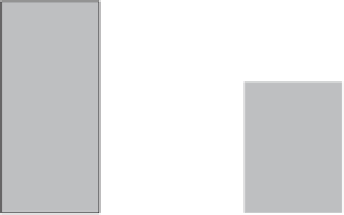Biology Reference
In-Depth Information
120%
100%
80%
60%
40%
20%
0%
A
B
Fig. 1. Percent survival.
Borrelia burgdorferi
strain B31A3 was grown to a cell
density of5×10
7
cells/mL in BSK II under anaerobic conditions, the culture divided
in half and each was treated with 0 (
A
)or2m
M
(
B
)
t
-butyl peroxide at 34 °C for 4
h. After treatment, cells were diluted in fresh BSK II, plated on BSKII plating media,
and incubated for 7-14 days at 34 °C in an anaerobic gas jar. Percent survivability
was calculated as the number of colonies on the treated plates versus the number of
colonies on the untreated plates.
60
50
40
30
20
10
0
A
B
C
D
E
Fig. 2. Quantitation of DNA damage.
Borrelia burgdorferi
B31A cells were grown
in BSK-II under anaerobic conditions to a cell density of 5 × 10
7
cells/mL, treated
with 0, 10, or 50 m
Mt
-butyl peroxide (
C
,
D
, and
E
, respectively) for4hand
DNA isolated. The DNA was then mixed with an aldehyde-reactive probe (Oxford
Biomedical Research, Inc) labeled with biotin and detected with an HRP-streptavidin
conjugate. The color development was monitored at 450 nm. The number of aldehyde-
reactive probe (DNA base lesions)/10
5
bp DNA was determined using a standard curve.
Escherichia coli
TA4315 cells were grown in minimal media to OD
600
of 0.4, treated
with 0 or 100 m
M
H
2
O
2
for 30 min (
A
and
B
, respectively) and DNA isolated. The
number of base lesions was determined as described above.





Search WWH ::

Custom Search